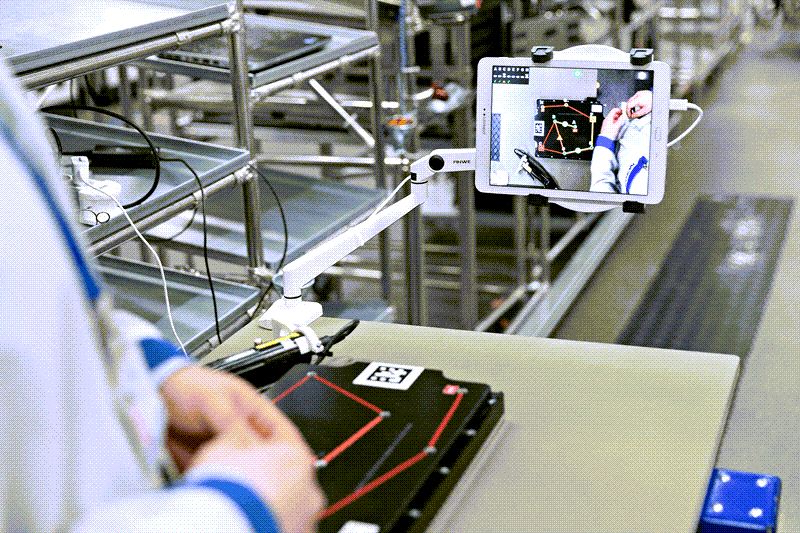5G networks provide an unprecedented level of speed and reliability in wireless connectivity. As 5G service becomes more widespread, these characteristics will enable the Industrial Internet of Things, allowing connected devices to make factories smarter and establishing a network infrastructure to support cutting-edge applications. The result? More dynamic and automated manufacturing processes.
As manufacturers look toward a digital future, the Industrial Internet of Things (IIoT) looms as a crucial building block. The next era of manufacturing – often referred to as the Fourth Industrial Revolution – hinges on reliable, real-time insights, made possible by analyzing and controlling the physical production line in real-time with digital technology.
“The first step of the Fourth Industrial Revolution is about connecting all assets,” said Guilherme Pizzato, head of ecosystem partners for manufacturing & logistics at telecommunications and consumer electronics giant Nokia. “Once connected, manufacturers can collect and analyze all available data and use that knowledge to make better, actionable decisions. This enables capabilities such as asset monitoring, predictive maintenance and advanced robotics.”
So far, however, IIoT’s potential for transformation has been unrealized due to the limited capabilities of previous generations of wireless communication networks – 2G, 3G and even 4G – which cannot offer the low latency (transmission delays) and security required for many of the IIoT’s most valuable applications. Neither can older-generation wireless technology support the high number of devices needed to enable a smart factory.
Therefore, while some aspects of manufacturing have been digitalized, most manufacturers still rely on hard-wired cabling to gather data about shop floor planning and operation, blocking their ability to reconfigure networks as requirements change. As a result, manufactures have not been able to fully exploit the potential of IIoT to optimize their operations – but 5G may soon change that picture foreve
A Dawning Revolution
With far greater speeds, lower latency, more reliable connectivity and the capacity to support a high number of connected devices, 5G should make possible a wide range of applications for individual consumers and entire industries.
While 5G is being touted to consumers for high-quality streaming and faster downloads, its implications for industry could be much more significant.
“5G is not just an evolution, but more of a revolution,” said Andreas Mueller, general chair of industry association 5G-ACIA, based in Germany. “In contrast to previous generations, where development was focused on connecting phones, 5G has a very strong focus on connecting all kinds of IIoT devices to deliver new capabilities across many different industries. While we will get higher data rates with 5G, it will also provide very low latency, very high reliability and very high efficiency, enabling it to offer advantages over previous generations of wireless systems.”
“With 5G’s capacity to support a very high density of devices, enterprises can realize different use cases with very diverse requirements at the same location at the same time." - Guilherme Pizzato (Head of ecosystem partners for manufacturing & logistics, Nokia)
5G’s improved speed and bandwidth will allow manufacturers to process more data from an advanced network of sensors, facilitating the easy, precise and secure collection and analysis of the massive volumes of production data that will pour from sensor-rich factory floors. By utilizing this additional information, manufacturers can make more informed decisions to increase operational efficiency.
“With 5G’s capacity to support a very high density of devices, enterprises can realize different use cases with very diverse requirements at the same location at the same time,” Nokia’s Pizzato said. “There’s a lot of potential in augmented and virtual reality, for example. These can be used for monitoring production, for training, for remote support, and for other features that can provide immediate benefits. If you have 5G, you can wirelessly connect to get real-time information from assets and production lines and avoid having a cable that prevents you from moving around freely.”
Real-Time Connectivity
5G also will let manufacturers combine the internal workings of their smart factories with external elements, including production-relevant data from logistics companies, suppliers, products-in-use and maintenance data. Simulating the supply chain and ensuring end-to-end traceability across the entire business lifecycle will allow manufacturers to react more quickly to changing circumstances, helping them manage disruption and miss fewer deadlines. 5G also will give manufacturers more insights into their supply chains, helping them to identify areas of waste and forecast demand more accurately, while reducing the costs of excessive inventory or unexpected shifts in production volumes.

Vodafone is among the telecommunications companies setting up 5G networks across the world, which will give manufacturing companies unprecedented levels of wireless capabilities in their factories. (Image © Vodafone)
To understand the potential for 5G in enabling IIoT applications that extend beyond the factory floor, Erik Brenneis, IoT director at Vodafone Business suggests imagining a fleet of autonomous forklifts or transport vehicles.
“You need real-time connectivity to achieve a consistent view of your operations,” he said. “IoT, powered by 5G, allows you to connect both your control centers and your vehicles to the outside logistics chain so you can oversee and efficiently manage different elements of your factory. When are my goods coming? Where are my automated vehicles in the factory? What’s the status of my machines? You can monitor and control that in real time, and that’s a game-changer compared to what you could do with previous network technologies.”
Creating Virtual Twins
creating intelligent plant ecosystems, the next challenge will be using the insights from those ecosystems to improve operations. While smart factories have the potential to be significantly more efficient than existing methods of production, manufacturers will need to focus on maintaining and extending their competitive advantages by quickly extracting insights from massive volumes of data. Modeling and simulating both the supply chain and physical assets will help transform both the business model and production processes, increasing efficiency, output and quality.
Virtual twins of their production lines will help manufacturers to understand what the data means in context and act on it quickly. These dynamic, multi-physics digital models of the elements and operations of any physical object or process transform data into quick-to-interpret visuals. Virtual twins therefore help manufacturers assess, share and validate different scenarios and production opportunities by aggregating data from the production line, manufacturing equipment, people and production plans – enabling products experts to run “what if” scenarios to identify, test and execute improvements.
"While we will get higher data rates with 5G, it will also provide very low latency, very high reliability and very high efficiency, enabling it to offer advantages over previous generations of wireless systems." - Andreas Mueller (General chair, 5G-ACIA)
Because they incorporate AI and machine-learning, virtual twins can also learn from and react to real-time data relayed by a 5G-IIoT ecosystem in the context of pre-set parameters, dynamically adjusting shop floor activities or offering their human partners suggestions for improvements to material and product flows. Virtual twins also can flag performance, quality and maintenance issues so that they can be addressed quickly, before they shut down production. Furthermore, enabling everyone within an organization to access shared 3D visualization opens new paths for collaboration.

Through its 5G enabled smart factory in Oulu, Nokia has reported a 30% increase in productivity and a 50% decrease in “time of product delivery to market, and an annual cost savings of millions of euros.” (Image © Nokia)
“5G-IIoT is an enabler for change in the ways in which we produce, so that we can get away from the very static production lines that we still have today,” Mueller said. “We can adapt to a very flexible type of production in which the production line can be quickly reconfigured. In extreme cases, you could reconfigure several times a day in order to resolve an issue, because 5G-IIoT makes it so much easier to do so.”
Establishing Trust
While few significant technological barriers remain in bringing 5G-IIoT to factories, most industry players have not yet embraced the technology, with the amount of testing in the real world remaining limited Much work remains for manufacturers, machine and equipment providers, platform providers and wireless connectivity infrastructure suppliers to demonstrate the reliability of 5G and IIoT for industrial settings and establish trust within the wider industry.
“It's a journey,” 5G-ACIA’a Mueller said. “We have a vision now of where we want to go, but there are more things to be done. What is still missing is an extensive validation of the [5G] performance in real-world environments. You need a certain level of trust in the technology to rely on 5G for your production. We have to establish that trust, and that’s why we need extensive test beds and trials in the real world.”
Despite this, Mueller is convinced that those who lead the way in adopting more flexible models of production stand to gain the greatest advantage.
“I can personally see the market start really taking off in 2022,” he said. “But it’s important that companies don’t wait until this happens to develop a 5G strategy, because by then it might be too late. It's important that everybody understands the developments that come along with 5G early on and adopts an effective strategy to take advantage of it. Be a pioneer and not a follower of the trend.”
Nguồn: https://compassmag.3ds.com/
Tác giả: admin_imalog
Ý kiến bạn đọc
Những tin mới hơn
Những tin cũ hơn
Thứ tư - 31/12/2025 03:12
Thứ sáu - 26/12/2025 04:12
Thứ sáu - 26/12/2025 01:12
Thứ năm - 25/12/2025 03:12
Thứ hai - 22/12/2025 05:12
Thứ hai - 22/12/2025 04:12
Thứ hai - 22/12/2025 03:12
Thứ tư - 17/12/2025 03:12
Thứ tư - 17/12/2025 01:12
Chương trình Tuyển dụng & Đào tạo Đặc biệt dành cho Sinh viên từ trường Đại học Bình Dương Các bài báo khoa học được công bố trên tạp chí Quốc Tế (08/2012)
Các bài báo khoa học được công bố trên tạp chí Quốc Tế (08/2012)
 Học bổng tân sinh viên Trường Đại học Bình Dương năm 2021
Học bổng tân sinh viên Trường Đại học Bình Dương năm 2021
 Sơ đồ CTĐT
Sơ đồ CTĐT
 03 lí do bạn nên học ngành Logistics & Quản lý chuỗi cung ứng tại BDU
03 lí do bạn nên học ngành Logistics & Quản lý chuỗi cung ứng tại BDU
 Thư mời tham dự Triển lãm về Logistics Việt Nam 2023
Thư mời tham dự Triển lãm về Logistics Việt Nam 2023
 VIỆN QUẢN TRỊ CÔNG NGHIỆP & LOGISITCS (IMALOG) THAM GIA TRIỂN LÃM QUỐC TẾ LOGISTICS- VILOG 2023
VIỆN QUẢN TRỊ CÔNG NGHIỆP & LOGISITCS (IMALOG) THAM GIA TRIỂN LÃM QUỐC TẾ LOGISTICS- VILOG 2023
 Thông báo tổ chức “Tuần sinh hoạt công dân - sinh viên” năm học 2023-2024
Thông báo tổ chức “Tuần sinh hoạt công dân - sinh viên” năm học 2023-2024
 Học bổng Hubert H. Humphrey tuyển ứng viên năm học 2022-2023
Học bổng Hubert H. Humphrey tuyển ứng viên năm học 2022-2023
 Hội thảo trực tuyến "Vận hành hiệu quả Cảng Thông Minh"
Hội thảo trực tuyến "Vận hành hiệu quả Cảng Thông Minh"
 Nhận ngay học bổng “khủng” khi nhập học trước 15/9- Ngành Quản trị Chuỗi cung ứng và Logistics
Nhận ngay học bổng “khủng” khi nhập học trước 15/9- Ngành Quản trị Chuỗi cung ứng và Logistics
 Cơ cấu tổ chức
Cơ cấu tổ chức
 Sinh viên BDU đại học chính quy khóa tuyển sinh năm 2020 trở về trước tại cơ sở chính được nộp học phí học kỳ I năm học 2021 – 2022 thành 2 đợt
Sinh viên BDU đại học chính quy khóa tuyển sinh năm 2020 trở về trước tại cơ sở chính được nộp học phí học kỳ I năm học 2021 – 2022 thành 2 đợt